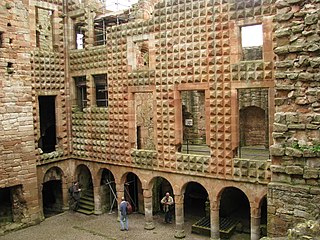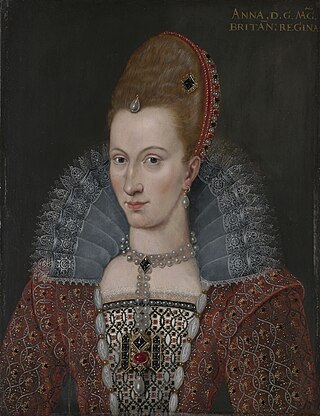Related Research Articles

Walter Scott, 5th of Buccleuch, 1st Lord Scott of Buccleuch was a Scottish nobleman and famous border reiver, known as the "Bold Buccleuch" and leader of Kinmont Willie's Raid.

George Home, 1st Earl of Dunbar, KG, PC was, in the last decade of his life, the most prominent and most influential Scotsman in England. His work lay in the King's Household and in the control of the State Affairs of Scotland and he was the King's chief Scottish advisor. With the full backing and trust of King James he travelled regularly from London to Edinburgh via Berwick-upon-Tweed.

Francis Stewart, 5th Earl of Bothwell, was Commendator of Kelso Abbey and Coldingham Priory, a Privy Counsellor and Lord High Admiral of Scotland. He was a notorious conspirator who led several uprisings against his first cousin, King James VI, all of which ultimately failed, and he died in poverty in Italy after being banished from Scotland. Francis's maternal uncle, the 4th Earl of Bothwell, was the chief suspect in the murder of James VI's father, Lord Darnley.
Sir John Carmichael was a Scottish soldier, the Keeper of Liddesdale, a diplomat, and owner of Fenton Tower at Kingston, East Lothian.
Robert Bowes (1535?–1597) was an English diplomat, stationed as permanent ambassador to Scotland from 1577 to 1583.
John Carey, 3rd Baron Hunsdon was an English peer, politician and Governor of Berwick-upon-Tweed.
Sir William Bowes of Streatlam,, was an English ambassador to Scotland, Deputy Warden of the West March, Treasurer of Berwick-upon-Tweed, and Member of Parliament for Westmorland.
Sir George Selby (1557–1625) was an English politician who sat in the House of Commons between 1601 and 1611.

Thomas Fowler was an English lawyer, diplomat, courtier, spy, servant of the Countess of Lennox, broker of the marriage of Mary, Queen of Scots and Lord Darnley, steward of the Earl of Leicester, advisor to James VI of Scotland and the Scottish ambassador in London, Archibald Douglas.

Wark on Tweed Castle, sometimes referred to as Carham Castle, is a ruined motte-and-bailey castle at the West end of Wark on Tweed in Northumberland. The ruins are a Grade II* listed building.
John Arnot of Birswick (Orkney) (1530–1616) was a 16th-century Scottish merchant and landowner who served as Lord Provost of Edinburgh from 1587 to 1591 and from 1608 to death. He was Deputy Treasurer to King James VI.
George Young was a Scottish churchman, courtier, member of the Privy Council of Scotland, diplomat, and secretary depute.
William Selby, was an English member of parliament and soldier at Berwick upon Tweed.

Jacob Kroger, was a German goldsmith who worked for Anne of Denmark in Scotland and stole her jewels.
George Nicholson or Nicolson, was an English diplomat in Scotland.
George Douglas of Longniddry was a Scottish landowner and courtier.
Nicolas Errington was an English soldier, military engineer, and administrator.
John Crane was a soldier and comptroller of works at Berwick-upon-Tweed during the reigns of Elizabeth I and James VI and I.

Anne of Denmark (1574–1619) was the queen of Scotland from her marriage by proxy to King James VI on 20 August 1589 and queen of England and Ireland from his accession on 24 March 1603 until her death in 1619. When Anne intended to sail to Scotland in 1589 her ship was delayed by adverse weather. Contemporary superstition blamed the delays to her voyage and other misfortunes on "contrary winds" summoned by witchcraft. There were witchcraft trials in Denmark and in Scotland. The King's kinsman, Francis Stewart, 5th Earl of Bothwell came into suspicion. The Chancellor of Scotland John Maitland of Thirlestane, thought to be Bothwell's enemy, was lampooned in a poem Rob Stene's Dream, and Anne of Denmark made Maitland her enemy. Historians continue to investigate these events.

Thomas Musgrave, Captain of Bewcastle was an English landowner and soldier involved in Scottish border politics. He was keeper of Bewcastle Castle for Elizabeth I.
References
- ↑ Charles H. Hunter Blair, "Wardens and deputy wardens of the Marches of England towards Scotland in Northumberland and the English wardens of Berwick upon Tweed", Archaeologia Aeliana, 28 (1950), p. 73. doi : 10.5284/1060129
- ↑ Joseph Bain, Calendar State Papers Scotland: 1547-1562, vol. 1 (Edinburgh, 663), pp. 661-2.
- ↑ Border Papers, vol. 1 (Edinburgh, 1894), p. 78
- ↑ George Lasry, Norbert Biermann, Satoshi Tomokiyo, 'Deciphering Mary Stuart’s lost letters from 1578-1584', Cryptologia, (8 Feb 2023), pp. 1-102
- ↑ William Boyd, Calendar State Papers Scotland: 1586-1588, vol. 9 (Edinburgh, 1915), p. 558 no. 456.
- ↑ Calendar State Papers Scotland, vol. 10 (Edinburgh, 1936), p. 166.
- ↑ Calendar State Papers Scotland, vol. 10 (Edinburgh, 1936), pp. 369, 385.
- ↑ Calendar State Papers Scotland, vol. 10 (Edinburgh, 1936), p. 449.
- ↑ Calendar State Papers Scotland, vol. 10 (Edinburgh, 1936), pp. 457, 460, 463, 471, 487, 531.
- ↑ Joseph Bain, Calendar of Border Papers, vol. 1 (Edinburgh, 1894), pp. 538-9.
- ↑ William Greenwell, Wills and Inventories from the Registry at Durham, vol. 2 (Surtees Society, Durham, 1860), pp. 256-8.